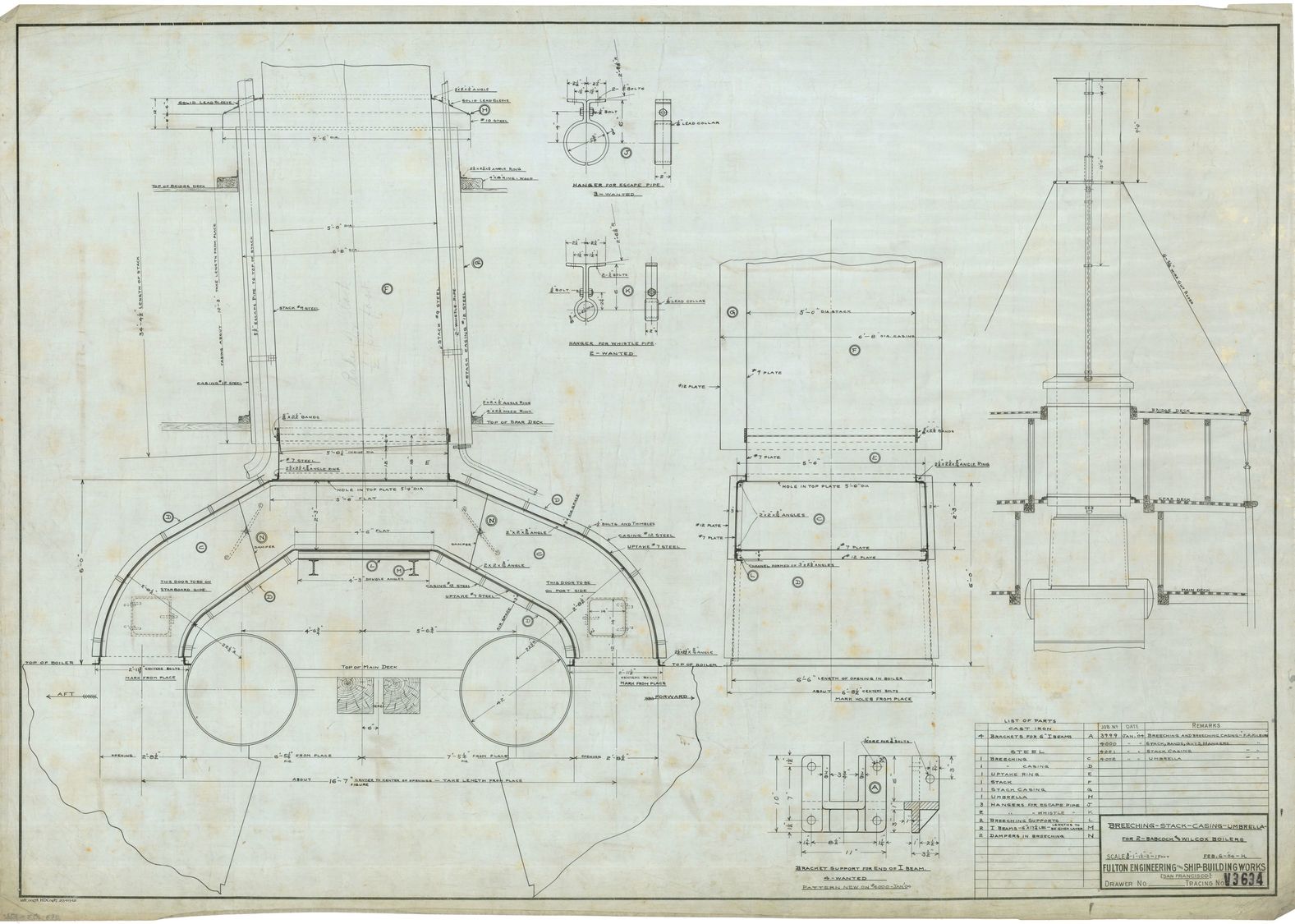Last updated: June 3, 2025
Lesson Plan
Boiler Room Experiment - Hercules STEAM Unit Lesson #3

A line drawing of a plan for the Babcock & Wilcox boiler(s), circa 1904.
Photo/NPS
- Grade Level:
- Upper Elementary: Third Grade through Fifth Grade
- Subject:
- Literacy and Language Arts,Science
- Lesson Duration:
- 60 Minutes
- Common Core Standards:
- 4.SL.1
- Additional Standards:
- NGSS-4-PS3-1: Use evidence to construct an explanation...[Energy Transfer]
NGSS-4-PS3-2: Make observations to provide evidence...[Energy Transfer]
NGSS-4-PS3-3: Ask questions and predict outcomes...[Energy Transfer] - Thinking Skills:
- Remembering: Recalling or recognizing information ideas, and principles. Understanding: Understand the main idea of material heard, viewed, or read. Interpret or summarize the ideas in own words. Applying: Apply an abstract idea in a concrete situation to solve a problem or relate it to a prior experience. Analyzing: Break down a concept or idea into parts and show the relationships among the parts. Evaluating: Make informed judgements about the value of ideas or materials. Use standards and criteria to support opinions and views.
Essential Question
How is energy transferred so that Hercules can travel? How do communities face change?
Objective
Learner will be able to explain how water transfers to steam at a molecular level.
Background
When water is heated up, the molecules move faster and there is more space between the molecules. In this process, heat energy is transferred to mechanical energy.
Preparation
1. Print worksheets
2. Obtain class set of laptops/tablets capable of using Google/Apple app.
3. Set up experiment.
A. Gather water, beaker, portable bunsen burner/camping stove, and tongs.
Materials
PowerPoint slides for lesson
Document for student observations, drawings, and notes.
Download Observational Drawing & Notes
Comprehensive curriculum for 14-lesson Hercules STEAM unit.
Lesson Hook/Preview
We know Hercules is steam-powered, but where does steam come from?
In this lesson, we're going to observe chemical reactions and energy transfer through experiments and simulations.
Procedure
1. Revisit Boiler Room in San Francisco Maritime TimeLooper Xplore App: replay video
2. Classroom share: What did you observe? What questions do you still have?
3. Show picture of boiler system and link to fire and water experiment.
4. Experiment: Demonstrate for students by turning on the bunsen burner. When the fire is started, add a beaker of water to the top. Allow students to observe water converting to steam. Students take notes & draw observations.
5. Classroom share: What did you observe? What do you think is happening?
6. Link experiment to pHet model: Explain that molecules are the smallest functional unit of matter. Everything is made up of molecules, but they are so small that our eyes can't see them. We use simulations to think about what happens to water molecules when they transfer from liquid to steam.
7. Student Experiment: Allow students to experiment with the pHet model. Students take notes and draw observations.
8. Introduce additional vocabulary (speed, space) and sentence frames ("I notice that the speed of water/steam molecules...", "I notice that the space between the water/steam molecules...")
9. Classroom share: What did you observe? What do you think in happening? How does this relate back to the boiler room?
10. Introduce the idea of energy transfer: Energy is never lost or gained--it is converted from one for mto another. For example, when we eat food so we can move around, we convert the energy from the food into movement/mechanical energy. When we plug in a hair dryer, we convert electrical energy to heat energy. What are the two kinds of energies involved in this conversion process? How do we know?
Vocabulary
- Molecule: smallest unit of matter that take part in a chemical reaction
- Energy: the ability to do work, make things happen, and cause changes
- Chemical energy: energy that is stored in chemicals and involved in reactions
- Thermal energy: energy in the form of heat
- Mechanical energy: energy in the form of movement
- Energy transfer: process in which energy is converted from one form to another, like chemical energy to mechanical energy (calories consumed -> time/distance walked)
- Chemical reaction: a process in which one or more substances undergoes a change to become a new substance (heat + water = steam)
Assessment Materials
Individual ReflectionObservation-wonder activity allowing students to reflect on current and past lessons and ponder future questions.
Supports for Struggling Learners
- Review vocabulary beforehand (included in PowerPoint).
- Strategically partner students so that they are provided with additional supports.
- Sentence frames (included in PowerPoint).
Enrichment Activities
Challenge students to draw experiment at molecular level.
Additional Resources
Online interactive simulator of energy transfer and the effects on the molecular level: https://phet.colorado.edu/en/simulations/energy-forms-and-changes.
Related Lessons or Education Materials
This is lesson 3 of the 14-lesson Hercules STEAM Unit. At minimum, this lesson should be done with lesson 2.
The Hercules STEAM Unit provides students with an understanding of life in the early 1900s.
Students will begin by becoming a historian and observing primary sources of information to answer the question: What is Hercules?
Then, they will get to deeply understand how Hercules’ engine works.
They will be able to observe a series of experiments and simulations to comprehend how steam engines function at a molecular level and identify the energy transfers.
Finally, students will have the opportunity to become engineers themselves. They will build a tugboat and present their learnings to a National Park Ranger
